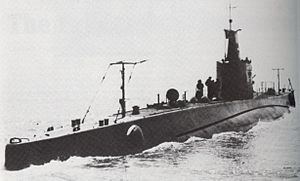Name Leonardo da Vinci Fate Sunk 24 May 1943 Construction started 19 September 1938 Length 70 m | Homeport BETASOM, Bordeaux Draught 4.72 m (15.5 ft) Launched 16 September 1939 Beam 6.82 m | |
 | ||
Class and type Marconi-class submarine Displacement 1,175 long tons (1,194 t) standard
1,465 long tons (1,489 t) full load Builder Cantieri Riuniti dell'Adriatico | ||
Leonardo da Vinci was a Marconi-class submarine of the Italian navy during World War II. It operated in the Atlantic from September 1940 until its loss in May 1943, and became the top scoring non-German submarine of the entire war.
Contents
Construction
Leonardo da Vinci was built at the CRDA shipyard in Monfalcone, near Trieste, Italy’s leading submarine builder. One of six boats of the Marconi class, which were laid down in 1938-39, Leonardo da Vinci was launched in September 1939. Designed as an ocean-going vessel, she was intended for operations both in the Mediterranean and in the Atlantic.
Service history
With Italy’s entry into World War II in June 1940 Leonardo da Vinci was dispatched to the Atlantic to Bordeaux in occupied France to serve in the Italian submarine flotilla there, BETASOM. She arrived October 1940 after a successful transit of the Straits of Gibraltar, scene of a number of Axis submarine losses.
Leonardo da Vinci carried out 11 war patrols, sinking 17 ships of 120,243 GRT, which included the 21,500-ton ocean liner RMS Empress of Canada. Leonardo da Vinci was Italy's most successful submarine in World War II, and her captain, Lt. Gianfranco Gazzana-Priaroggia, Italy's leading submarine ace. In July 1942 Leonardo da Vinci was assigned to a special operation aimed at mounting raids on harbours on the eastern seaboard of the United States. To this end she was converted to carry a CA-class midget submarine, and during the autumn engaged in trials with the new weapon. However, the operation was delayed due to the need for modifications to the CA craft and Leonardo da Vinci returned to action to the Atlantic.
On 19 March 1943 Leonardo da Vinci torpedoed and sank the 7,628 ton British cargo ship SS Lulworth Hill in the South Atlantic. Leonardo da Vinci captured and took on board one survivor; two other men survived following a 50-day ordeal on a liferaft.
In April 1943 Leonardo da Vinci sank three vessels in the Indian Ocean off the coast of Durban.
Fate
After sinking four more ships, on 22 May 1943 Leonardo da Vinci unwisely signalled its intention to head for Bordeaux on completion of its patrol. Its position having been fixed by direction-finding, on 23 May the destroyer HMS Active and the frigate HMS Ness (both escorts to convoys WS-30 and KMF-15) subjected the submarine to an intense depth charge attack and sank it 300 miles (480 km) west of Vigo at an estimated position of 42°16′0″N 15°40′0″W. There were no survivors.
